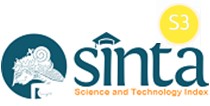Transportation Demand Omotenashi at Ijen Corridor: The problems and development strategies
Abstract
Keywords
Full Text:
PDFReferences
[1] de Palma A, Lindsey R. Transportation: Supply and Congestion. International Encyclopedia of the Social & Behavioral Sciences, Elsevier; 2001, p. 15882–8. https://doi.org/10.1016/B0-08-043076-7/02318-4.
[2] Litman T. The Online TDM Encyclopedia: Mobility Management Information Gateway. Transp Policy (Oxf) 2003;10:245–9. https://doi.org/10.1016/S0967-070X(03)00025-8.
[3] Marshall S, Banister D. Travel Reduction Strategies: Intentions And Outcomes. Transp Res Part A Policy Pract 2000;34:321–38. https://doi.org/10.1016/S0965-8564(99)00034-8.
[4] Chen C-F, Lai W-T. The Effects Of Rational And Habitual Factors On Mode Choice Behaviors In A Motorcycle-Dependent Region: Evidence from Taiwan. Transp Policy (Oxf) 2011;18:711–8. https://doi.org/10.1016/j.tranpol.2011.01.006.
[5] Van Malderen L, Jourquin B, Thomas I, Vanoutrive T, Verhetsel A, Witlox F. On The Mobility Policies of Companies: What are The Good Practices? The Belgian Case. Transp Policy (Oxf) 2012;21:10–9. https://doi.org/10.1016/j.tranpol.2011.12.005.
[6] Steg L, Vlek C. The Role of Problem Awareness in Willingness-to-Change Car Use and in Evaluating Relevant Policy Measures. 1997.
[7] Santos G, Behrendt H, Maconi L, Shirvani T, Teytelboym A. Part I: Externalities and Economic Policies in Road Transport. Research in Transportation Economics 2010;28:2–45. https://doi.org/10.1016/j.retrec.2009.11.002.
[8] Hounsell N, Shrestha B, Piao J. Enhancing Park and Ride with Access Control: A Case Study of Southampton. Transp Policy (Oxf) 2011;18:194–203. https://doi.org/10.1016/j.tranpol.2010.08.002.
[9] Caicedo F. Charging Parking by The Minute: What to Expect from this parking Pricing Policy? Transp Policy (Oxf) 2012;19:63–8. https://doi.org/10.1016/j.tranpol.2011.09.006.
[10] Meyer MD. Demand Management as an Element of Transportation Policy: Using Carrots and Sticks to Influence Travel Behavior. Transp Res Part A Policy Pract 1999;33:575–99. https://doi.org/10.1016/S0965-8564(99)00008-7.
[11] May AD, Tight MR. Innovation and Integration in Urban Transport Policy. Transp Policy (Oxf) 2006;13:281–2. https://doi.org/10.1016/j.tranpol.2005.12.001.
[12] Vieira J, Moura F, Manuel Viegas J. Transport Policy and Environmental Impacts: The Importance of Multi-Instrumentality in Policy Integration. Transp Policy (Oxf) 2007;14:421–32. https://doi.org/10.1016/j.tranpol.2007.04.007.
[13] Kubota H, Uemura T, Kojo M, Sakamoto K. Transportation Demand Omotenashi (TDO). Infrastructure Planning Review 2006;23:711–6. https://doi.org/10.2208/journalip.23.711.
[14] Monden Y. Management of Service Businesses in Japan. World Scientific; 2012.
[15] Suhudi, Tenabolo A. Analisis TIngkat Pelayanan Jalan Sunan Kalijaga Kelurahan Dinoyo Kecamatan Lowokwaru Kota Malang. Jurnal Reka Buana 2017;2.
[16] Kawulur DO, Naukoko AT, ThB Maramis M, Ekonomi Pembangunan J, Ekonomi dan Bisnis F. Analisis Dampak Kemacetan Terhadap Ekonomi Pengguna Jalan, Depan Tugu Taman Kota Manado. n.d.
[17] Yunas NS, Huda M. Kebijakan Revitalisasi Sistem Transportasi Publik Sebagai Langkah Antisipatif Kemacetan Total di Kota Malang. CosmoGov 2017;3:116. https://doi.org/10.24198/cosmogov.v3i1.12639.
[18] Ratri N. Jumlah Kendaraan Bertambah 110 Ribu Unit Per Tahun, Barenlitbang Kota Malang Buru Solusi Atasi Kemacetan. MalangTimesCom 2018. https://www.malangtimes.com/baca/26407/19700101/070000/jumlah-kendaraan-bertambah-110-ribu-unit-per-tahun-barenlitbang-kota-malang-buru-solusi-atasi-kemacetan.
[19] Damargita A, Rini Dwi Ari I, Widyawati Agustin I. Indonesian Green Technology Journal Revitalisasi Pelayanan Angkutan Kota Malang Berdasarkan Persepsi Stakeholder (Studi Kasus : Trayek LDG). n.d.
[20] Kurniati S. Kajian Penerapan Transportation Demand Omotenashi (TDO) di Kawasan Tugu Kota Malang. Sarjana thesis. Universitas Brawijaya, 2014.
[21] Agustin IW, Adhianti RAC, Fikriyah, Shakia NF, Maulidiah IA. Exploring the Role of Transportation Demand Omotenashi (TDO) in the City Center Plaza of Batu. IOP Conf Ser Earth Environ Sci 2019;328:012024. https://doi.org/10.1088/1755-1315/328/1/012024.
[22] Donnelley. A Policy Statement for Scotland Designing Street. Edinburgh: The Scottish Government; 2010.
[23] Kementerian Pekerjaan Umum. Highway Manual Capacity Indonesia 1997.
[24] Putra S, Purbanto R, Negara NW. Analisis Tingkat Pelayanan Fasilitas Pejalan Kaki (Studi kasus: Jln. Diponogoro di Depan Mall Ramayana). Jurnal Ilmiah Elektronik Infrastruktur Teknik Sipil 2013;2.
[25] Syukri SHA. Penerapan Customer Satisfaction Index (Csi) Dan Analisis Gap Pada Kualitas Pelayanan Trans Jogja. Jurnal Ilmiah Teknik Industri 2014;13.
[26] Andriani GN, Ardiansyah LO, Sulistio H, Wicaksono A. Kajian Lokasi Halte Dan Jam Operasi Angkutan Kota Malang Berdasarkan SPM 2015 (Studi Kasus: Trayek LDH, AH, dan ADL). IPTEK Journal of Proceedings Series 2017;3. https://doi.org/10.12962/j23546026.y2017i5.3121.
[27] Adam AM. Sample Size Determination in Survey Research. J Sci Res Rep 2020:90–7. https://doi.org/10.9734/jsrr/2020/v26i530263.
[28] Xiao A. Konsep Interaksi Sosial Dalam Komunikasi, Teknologi, Masyarakat. Jurnal Komunika: Jurnal Komunikasi, Media Dan Informatika 2018;7. https://doi.org/10.31504/komunika.v7i2.1486.
[29] Destian F. Kajian Efektivitas Bus Trans Metro Bandung Trayek Leuwipanjang – Antapani. Skripsi. Institut Teknologi Nasional, 2019.
[30] Munthafa AE, Mubarok H. Penerapan Metode Analytical Hierarchy Process Dalam Sistem Pendukung Keputusan Penentuan Mahasiswa Berprestasi 2017;3.
[31] Ngalam Wearemania. Sisi Lain dan Nilai Sejarah Taman Simpang Balapan 2021. https://www.wearemania.net/ngalam/malangan/sisi-lain-dan-nilai-sejarah-taman-simpang-balapan/7920.Refbacks
- There are currently no refbacks.


.png)

.jpg)









